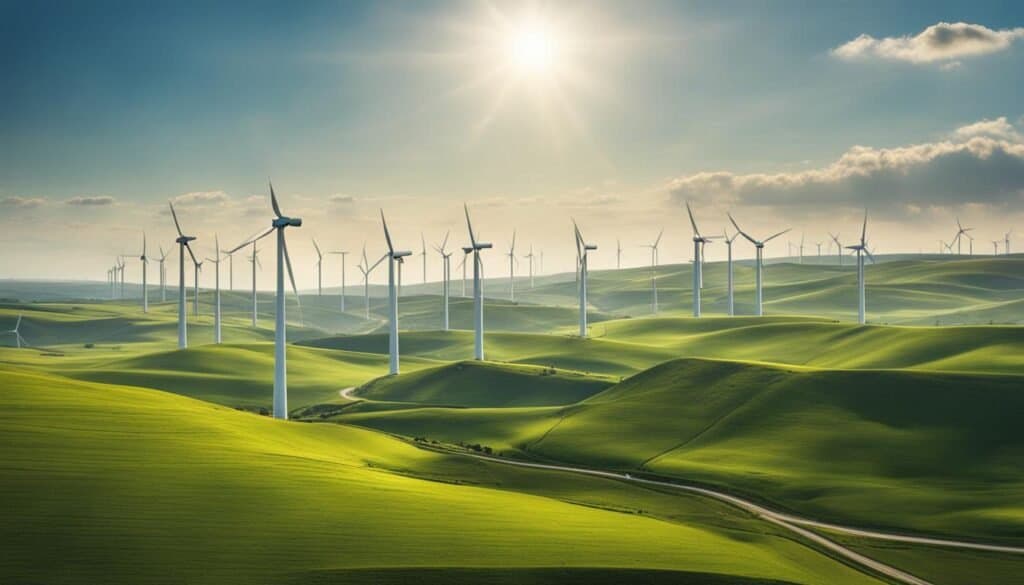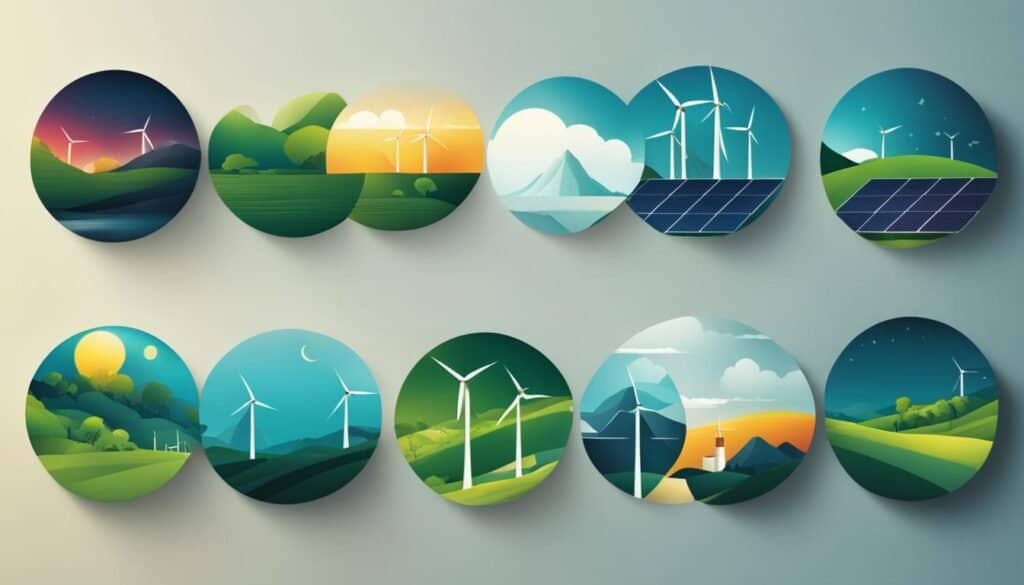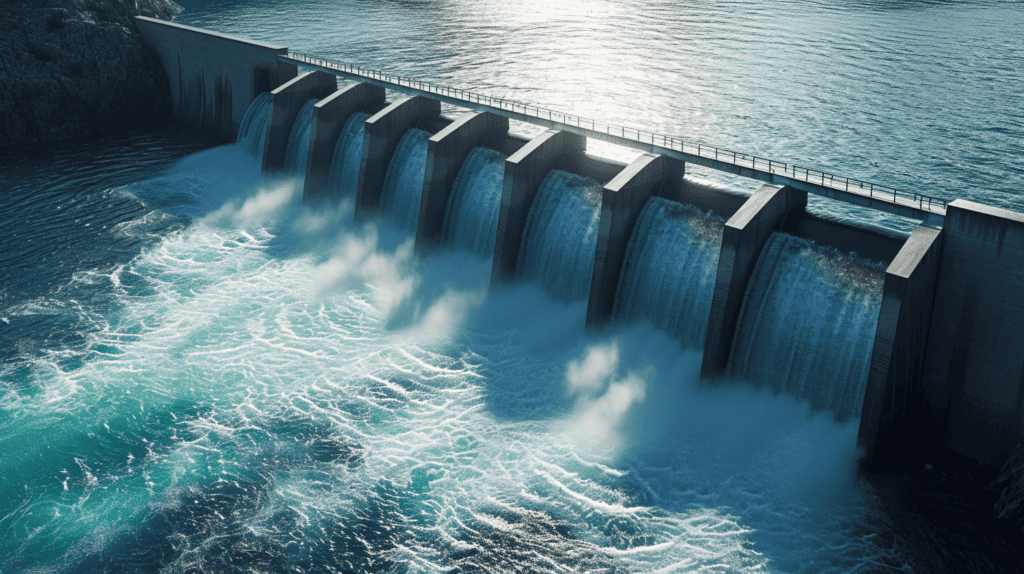As our world shifts towards a sustainable future, harnessing renewable energy sources has become essential in lowering energy consumption, reducing greenhouse gas emissions, and securing a clean energy future. With the remarkable advancements in energy technologies, multiple alternative energy sources, such as solar, wind, and hydroelectric power, have become more accessible and efficient, promising a significant impact on our energy economy. In this article, I will discuss some of the best renewable energy sources that offer superior energy efficiency while contributing to a greener, healthier environment.
Key Takeaways
- The importance of renewable energy sources in promoting energy efficiency and a clean energy future
- Various forms of renewable energy, such as solar, wind, and hydroelectric power, with a focus on their efficiency and environmental impact
- The role of energy technologies in advancing the performance and adoption of renewable energy sources
- Comparing the efficiency of different types of renewable energy sources to better understand their potential in the energy sector
- How harnessing renewable energy resources contributes to a sustainable and low-carbon energy economy
7 Top Renewable Energy Sources
Here are the 7 best renewable energy sources for efficiency, along with relevant details for each:
- Solar Power
- Efficiency: Solar panels typically convert 15-20% of sunlight into usable energy.
- Case Study: The Noor Complex Solar Power Plant in Morocco, one of the largest in the world, significantly contributes to the country’s goal of 42% renewable energy by 2020.
- Details: Solar power harnesses energy from the sun using photovoltaic cells. It’s most effective in sunny regions and can be used for electricity generation and heating.
- Wind Energy
- Efficiency: On average, wind turbines convert 35-40% of the wind’s kinetic energy into electricity.
- Case Study: The Gansu Wind Farm in China, the largest in the world, has a capacity of over 6,000 MW.
- Details: Wind energy utilizes turbines to generate electricity. Offshore wind farms tend to produce more consistent and higher speeds, increasing efficiency.
- Hydropower
- Efficiency: Modern hydroelectric turbines achieve efficiencies up to 90%.
- Case Study: The Three Gorges Dam in China, the world’s largest power station in terms of installed capacity (22,500 MW).
- Details: Hydropower generates electricity using flowing water. It’s highly efficient but depends on geographical and climatic conditions.
- Geothermal Energy
- Efficiency: Geothermal plants have efficiency rates between 10-20%, but their continuous availability makes them more reliable than other renewables.
- Case Study: The Hellisheiði Power Station in Iceland, one of the largest geothermal power stations, harnesses the volcanic landscape to generate electricity.
- Details: This energy is derived from the Earth’s internal heat. It’s consistent and powerful but limited to areas with geothermal activity.
- Biomass Energy
- Efficiency: Biomass conversion efficiency for electricity is typically about 20-25%.
- Case Study: In Sweden, biomass accounts for about half of the country’s renewable energy use, primarily from forestry waste.
- Details: Biomass energy uses organic materials like wood, agricultural crops, and waste. It’s versatile but its sustainability depends on careful resource management.
- Ocean Energy
- Efficiency: Tidal energy conversion rates are about 80%, but overall efficiency varies based on technology.
- Case Study: The Sihwa Lake Tidal Power Station in South Korea, the largest of its kind, with a capacity of 254 MW.
- Details: This includes tidal and wave energy, harnessing the ocean’s natural movements. It’s a vast but underexploited resource, mostly due to technological challenges.
- Hydrogen Fuel Cells
- Efficiency: Hydrogen fuel cells have an efficiency of around 40-60%.
- Case Study: Germany has been investing heavily in hydrogen fuel cell technology, aiming to become a global leader in this field.
- Details: These cells convert hydrogen into electricity, with water vapor as the only emission. Ideal for transportation, they’re clean but require significant energy for hydrogen production.
Each of these renewable energy sources offers a unique combination of efficiency and environmental benefits, making them integral to a sustainable energy future.
Understanding the Power of Renewable Energy
Renewable energy’s power stems from its utilization of limitless natural resources, such as solar and wind energy. The rising diversity of renewable options contributes to greener, more efficient energy production systems, as alternative energy forms like geothermal, solar, wind, hydroelectricity, and biomass demonstrate the remarkable capability of engineering and innovation to transform the energy landscape.
International Energy Agency: Improving industrial energy efficiency, as seen in China’s recent policies for its energy-intensive sectors, contributes significantly to overall energy efficiency and sustainability.
These environment-friendly energy forms not only offer a sustainable energy source but also play a crucial role in reducing energy dependencies and securing a cleaner future with reduced greenhouse gas emissions.
The Role of Natural Resources in Clean Energy Production
The use of abundant natural resources in renewable energy production leads to a reduced reliance on fossil fuels and a decrease in associated carbon emissions. Harnessing the power of low-carbon energy sources like solar, wind, and hydroelectricity offers an environmentally friendly alternative to traditional fossil fuel-based energy production methods. Renewable energy sources not only minimize the environmental impact but also contribute to improved energy security, as countries can rely more on their own available resources.
Why Renewable Sources Surpass Traditional Fossil Fuels
Compared to traditional fossil fuels, renewable sources of energy have numerous advantages. A sustainable energy system based on renewables works in harmony with the environment, avoiding significant damage to ecosystems and public health caused by carbon emissions. The transition to clean energy production aligns with goals of both energy security and sustainable development. Consequently, more and more nations are prioritizing the use of cleaner energy sources, moving toward a future of decreased reliance on fossil fuels and mitigation of their deleterious effects on the environment.
Renewable energy sources are the key to securing a safer, cleaner future with reduced greenhouse gas emissions, aligning energy security with sustainable development and demonstrating the power of engineering and innovation to transform the energy landscape.
The Transformative Impact of Solar Energy
With the potential to render fossil fuels obsolete, the transformative impact of solar energy lies in its endless supply. Solar cells within photovoltaic (PV) systems capture sunlight and convert it into usable forms of energy such as heat or electricity, fostering improved public health and reduced environmental strain. Investment in solar projects is encouraged by governments through fiscal incentives like rebates and tax credits.
Despite its high initial costs, solar energy promises to decrease energy bills over time, making it a viable long-term investment for households and businesses seeking to tap into this clean and abundant energy source. As solar technology continues to advance and costs diminish, solar energy stands to play a significant role in the clean energy shift, marking a remarkable stride toward energy autonomy and economic savings.
Rooftop solar panels and solar farms are two prominent examples of how solar photovoltaics are these days integrated on various scales. Both solutions help reduce energy consumption and contribute significantly to renewable electricity generation. Likewise, solar thermal energy uses the power of the sun to supply heat, establishing yet another means of harnessing this abundant energy source.
As solar technology continues to advance and costs diminish, solar energy stands to play a significant role in the clean energy shift, marking a remarkable stride toward energy autonomy and economic savings.
Below, we explore some of the latest trends in solar projects:
- Solar-powered electric vehicle charging stations
- Community solar power programs
- Integration of solar panels with smart home devices
- Development of more efficient and affordable solar cells
These trends are expected to boost the overall adoption of solar power worldwide, offering alternatives to conventional energy sources and further strengthening solar power’s already transformative impact.
Wind Energy: Harnessing the Breeze for Power

Wind energy is rapidly becoming one of the top renewable energy sources for energy generation and consumption. By using wind turbines in strategically placed wind farms, we can effectively harness the power of the wind – a byproduct of solar energy – to produce utility-scale energy that is both efficient and sustainable. Let’s explore the clean energy facet of wind farms and how they are impacting both the environment and the economy.
Clean Energy from Wind Farms
Wind farms consist of multiple wind turbines that work together to produce clean energy from the natural movement of air. This clean energy source is carbon-neutral, generating zero emissions that contribute to air pollution or an increase in greenhouse gases. Moreover, wind energy technologies are continually improving, resulting in numerous innovative turbine designs that maximize energy capture.
Wind energy has also proven to be a reliable and sustainable power source, working in tandem with other renewable sources, such as solar energy, to generate electricity for the grid. Offshore wind farms, located in high-wind areas, provide even greater capacity for energy production and have become a crucial component of the renewable electricity landscape.
Economic and Environmental Benefits of Wind Power
One of the driving factors behind the adoption of wind energy is the various economic benefits it offers. Wind farm projects are known to create jobs for the maintenance and operation of wind turbines, bolstering local economies and providing sustainable income for rural communities hosting these projects. The utility-scale energy production from wind farms also reduces energy needs from other, more environmentally harmful sources, such as fossil fuels, further promoting the transition to renewable energy.
- Energy efficiency improvements
- Reduced energy consumption
- Lower greenhouse gas emissions
- Job creation in the energy sector
- Stimulated local economies
- Diversified power sources
- Increase in renewable electricity generation
While challenges such as noise pollution, visual impact, and wildlife disturbance persist, the overall economic and environmental benefits of wind power cannot be overstated. As the renewable energy sector continues to evolve, wind energy will remain a vital part of a sustainable, clean energy future.
Renewable Energy Sources for Efficiency

When it comes to energy efficiency, renewable energy sources often outperform traditional fossil fuels, delivering cost-effective, environmentally friendly solutions for power generation. In recent years, the sphere of renewable energy has experienced a remarkable diversification of technologies that has given rise to competitive choices that can cater to different applications and locales. To understand how these sources of clean energy stand up against one another, exploring efficiency metrics and ranking them can illuminate the path towards a less carbon intensive, more sustainable future.
Efficiency Metrics in Renewable Energy
The chief parameters taken into account when measuring efficiency in renewable energy are the levelized cost of energy (LCOE) and the capacity factor. The LCOE encompasses the overall costs incurred over a power plant’s lifetime, including capital, operational, and maintenance expenses, all of which can vary greatly depending on the energy source. Meanwhile, the capacity factor gauges the plant’s utilization rate, revealing how much energy is generated as opposed to the maximum possible output.
Comparing the Efficiency Across Various Sources
The following table highlights the relative efficiency of different forms of renewable energy, taking into consideration both LCOE and capacity factor metrics:
| Renewable Energy Source | Levelized Cost of Energy (USD/MWh) | Capacity Factor (%) |
|---|---|---|
| Wind Power | 20 – 65 | 20 – 40 |
| Geothermal Energy | 40 – 100 | 70 – 95 |
| Hydropower | 30 – 90 | 30 – 70 |
| Solar Energy | 35 – 85 | 10 – 25 |
| Biomass | 50 – 110 | 70 – 90 |
| Ocean Energy | 80 – 300 | 20 – 70 |
| Hydrogen | 40 – 100 | 70 – 90 |
As can be gleaned from the data, wind energy is the frontrunner in efficiency for renewable energy. It consistently offers the lower LCOE and a substantial capacity factor, closely followed by geothermal, hydropower, and solar energy sources. As efficiency improves and costs diminish, the adoption of renewable energy escalates, indicating a prominent shift toward an increasingly diverse and efficient energy portfolio.
Engineers and innovators consistently work towards boosting the performance of renewable energy installations. To that end, they employ advanced technologies such as remotely operated vehicles (ROVs) to inspect and maintain energy plants with minimal downtime. In turn, these continued advancements drive the renewables sector towards heightened efficiency, cost competitiveness, and wider adoption, all of which contribute to the clean energy future the United States and the world aspires to achieve.
Eco-Friendly Advances in Hydro and Ocean Power

As the world transitions towards renewable and green energy sources, eco-friendly advances in hydroelectric power and ocean energy have emerged, harnessing the natural movement of water to generate electricity. These innovations have significantly contributed to the global shift towards clean, sustainable energy alternatives, offering numerous benefits and immense potential for eco-friendly power generation.
One of the most prominent renewable energy sources, hydroelectric power, often relies on large-scale dams or underwater turbines to generate electricity. These hydroelectric plants produce zero emissions, providing a cleaner energy resource that helps lower energy consumption and maintain a low-carbon energy profile.
Alongside hydro power, ocean energy presents a multitude of possibilities. Ocean energy sources — such as wave power, tidal power, and ocean thermal energy conversion systems — are derived from the thermal and mechanical forces of seawater, offering predictable and abundant energy for coastal cities. These innovative clean energy technologies have the potential to revolutionize renewable heating, renewable cooling, and energy storage solutions, leading to more sustainable energy systems.
“Ocean energy promises a consistent, predictable, and abundant supply of green energy that could help to power a cleaner, more sustainable future.”
While there are challenges associated with hydro and ocean power — such as minimizing environmental disruption and addressing the upfront cost of infrastructure — the benefits of these renewable sources far outweigh the drawbacks. Smart grids integrating multiple renewable energy sources, including hydro and ocean power, can contribute to a more sustainable, low-carbon energy system capable of meeting the world’s growing energy needs.
| Renewable Source | Type of Energy | Main Benefits |
|---|---|---|
| Hydroelectric Power | Mechanical Energy | Zero emissions, scalable, reliable |
| Wave Power | Mechanical Energy | Efficient, predictable, cost-effective |
| Tidal Power | Mechanical Energy | Scalable, long-lasting, predictable |
| Ocean Thermal Energy Conversion | Thermal Energy | Renewable heating and cooling, minimal environmental impact |
As technological advancements continue to be made in renewable energy infrastructure, hydroelectric power and ocean energy sources stand to play a critical role in shaping a cleaner, more sustainable future, offering consistent and eco-friendly energy alternatives that support the transition away from fossil fuels.
Conclusion on Renewable Energy Sources for Efficiency
In conclusion, the realm of renewable energy encompasses a suite of diverse and eco-friendly sources, each with unique properties advancing energy efficiency and sustainability. These resources form the bedrock of an organic, renewable energy matrix that supports energy security and protects our environment from the perils of fossil fuel consumption. The future of energy is one of collaboration, optimized by technology and innovation, to create a holistic and sustainable energy system.
Our sustainable future relies on shared responsibility, forward-thinking policies, and a commitment to safeguarding our planet while fulfilling global energy needs. The clean energy future consists of diversified sources such as solar, wind, hydro, and geothermal energy, all working together to ensure our energy independence. Simultaneously, renewable energy technologies continue to advance, ensuring the clean energy revolution generates efficient and reliable power.
Ultimately, investing in alternative energy sources and supporting the renewable energy sector will foster a more resilient and environmentally harmonious world. Joining the global energy transition movement will leave a lasting positive impact for generations to come.
FAQ on Types of Renewable Energy
Q: What are the types of renewable energy sources that are most crucial for energy efficiency?
A: The top five most efficient types of renewable energy sources for energy efficiency include solar power, wind and solar energy, hydropower, biomass, and natural gas.
Q: What role does solar power play in enhancing energy efficiency?
A: Solar power is crucial for energy efficiency due to its ability to generate energy by harnessing the sun’s rays. It is a renewable energy source that is abundant and readily available for harnessing, thus producing a significant amount of energy.
Q: What’s the projection for alternative energy use in the U.S by 2022?
A: As per the U.S Department of Energy and the Energy Information Administration, it is expected that the use of alternative energy, particularly wind and solar, will significantly increase in the U.S by 2022. This is part of the department’s efforts to promote renewable energy system and shift away from non-renewable energy sources.
Q: How does the use of natural gas compare to other energy sources in supporting energy efficiency?
A: Natural gas is considered one of the cleanest and most efficient ways to produce electricity. It not only produces a large amount of usable energy but also results in fewer emissions compared to other non-renewable energy options.
Q: What is the future of clean energy jobs in the United States?
A: The future of clean energy jobs in the United States is promising. With the country’s increasing shift towards renewable energy sources like wind and solar, the clean energy economy is bound to expand, creating more job opportunities in the sector.
Q: How does biomass contribute to energy efficiency?
A: Biomass, as a renewable energy source, contributes to energy efficiency by providing a source that can be continuously replenished. By using organic materials to generate energy, biomass offers a more sustainable way to produce electricity compared to traditional energy sources.
Q: Why is using renewable energy crucial for a safer future?
A: Using renewable energy is crucial for a safer future as it helps reduce our reliance on fossil fuels thus decreasing the harm caused to the Earth’s environment. They also contribute to the clean energy economy and are a great alternative for achieving energy efficiency.
Q: What role does hydropower play in energy efficiency, particularly in the U.S?
A: Hydropower plays a vital role in energy efficiency in the U.S. Apart from being a renewable energy source, it’s the largest source of clean, renewable electricity in the United States. The energy is produced by harnessing the power of flowing water to generate energy, contributing to a more sustainable and cleaner energy system.
Q: By 2050, what is the expectation for the renewable energy sector?
A: According to international renewable energy projections, by 2050, renewable energy sources are expected to provide a significant portion of the world’s energy needs, contributing greatly to energy efficiency.
Q: What role does energy efficiency play in the overall clean energy economy?
A: Energy efficiency is a key player in the overall clean energy economy. By opting for efficient renewable energy sources like solar power, wind, biomass and hydropower, we can significantly lower energy costs, reduce emissions, and create clean energy jobs, leading to a robust and sustainable clean energy economy.





Leave a Reply